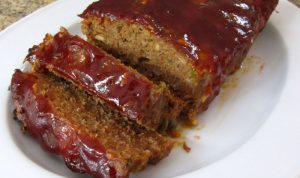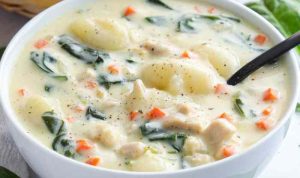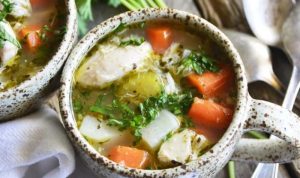Pea Soup with Ham Bone: A Hearty and Flavorful Classic: Pea Soup Recipe Ham Bone
Pea soup recipe ham bone – Pea soup, a culinary staple across numerous cultures, boasts a rich history and diverse regional variations. The addition of a ham bone elevates this humble dish to a level of savory depth and nutritional richness rarely found elsewhere. This recipe explores the history, nutritional benefits, and preparation of this comforting and flavorful soup.
Introduction to Pea Soup with Ham Bone, Pea soup recipe ham bone
Pea soup’s origins are ancient, with evidence suggesting its presence in various forms throughout history. The incorporation of ham bone, a practice prevalent in many European cuisines, adds a layer of umami richness and depth of flavor, transforming the soup into a hearty and satisfying meal. The ham bone contributes collagen, enriching the soup’s texture, while also lending a distinct savory profile.
From the simple split pea soups of the British Isles to the more elaborate versions found in Eastern Europe, the variations are countless, each reflecting regional culinary traditions and ingredient availability.
Nutritionally, pea soup with ham bone is a powerhouse. Peas are an excellent source of fiber, protein, and various vitamins and minerals, including vitamins A, C, and K, as well as folate and iron. The ham bone adds protein, contributing to the soup’s satiety and nutritional value. The combination provides a balanced meal offering essential nutrients for overall health.
Several types of peas are suitable for this recipe. Yellow split peas are a popular choice for their quick cooking time and creamy texture. Green split peas offer a slightly earthier flavor, while whole green peas provide a more substantial texture, requiring a longer cooking time. The choice ultimately depends on personal preference and desired consistency.
Ingredients and Preparation
Gathering the right ingredients is crucial for a successful pea soup. Below are the necessary components and a step-by-step preparation guide.
- Ham Bone Preparation:
- Obtain a ham bone (approximately 2-3 pounds) from a butcher or grocery store. Ensure it has some meat still attached.
- Rinse the ham bone thoroughly under cold water.
- Place the ham bone in a large stockpot and cover with cold water.
- Bring the water to a boil, then reduce heat and simmer for at least 2 hours, or until the meat is tender and easily pulls away from the bone. Skim off any foam that rises to the surface.
- Remove the ham bone from the pot and set aside to cool. Once cool enough to handle, remove the meat from the bone, shred it, and set it aside. You can reserve the bone for another use (e.g., stock).
- Pea Preparation:
- If using dried peas, rinse them thoroughly under cold water.
- Soak the dried peas in cold water for at least 4-6 hours, or preferably overnight. This significantly reduces cooking time and improves texture.
- Drain the soaked peas before adding them to the soup.
- Aromatic Preparation:
- Finely chop one large onion.
- Dice two carrots into small, roughly ½-inch pieces.
- Finely chop two celery stalks.
Cooking Methods and Techniques
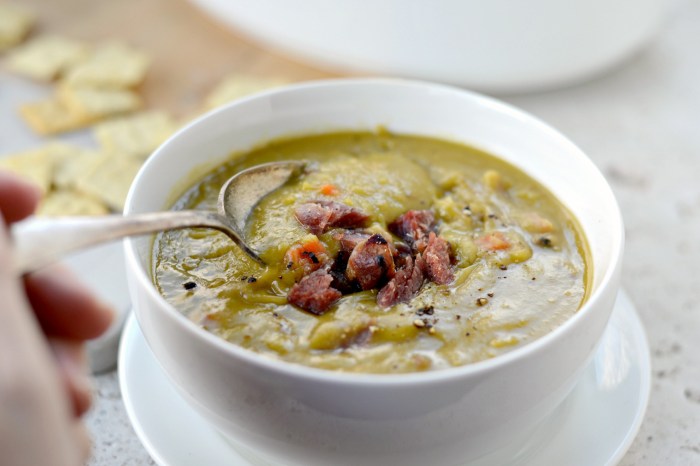
Source: simplyscratch.com
Several methods can be employed to cook pea soup, each with its own advantages and disadvantages.
| Method | Time | Advantages | Disadvantages |
|---|---|---|---|
| Stovetop | 2-3 hours | Consistent heat control, allows for easy adjustments. | Requires more attention and time. |
| Slow Cooker | 6-8 hours on low, or 3-4 hours on high | Hands-off cooking, develops deep flavors. | Less control over heat and consistency. |
| Pressure Cooker | 45-60 minutes | Significantly reduces cooking time, retains nutrients. | Requires specialized equipment, potential for uneven cooking if not monitored properly. |
Simmering is crucial for developing the full flavor and creamy texture of the soup. The longer simmering time allows the peas to break down, releasing their starch and creating a rich, velvety consistency. Adjusting seasoning throughout the cooking process is important for achieving the desired taste. Start with a base level of salt and pepper, adding more as needed.
A delicious pea soup recipe often incorporates a ham bone for extra depth of flavor. If you’re short on time, however, you might appreciate a faster approach; check out this helpful guide on quick soup recipe options for inspiration. Returning to our pea soup, remember that even a quick method can yield a flavorful and satisfying result with the addition of that ham bone.
Herbs such as thyme, bay leaf, or marjoram can be added during simmering to enhance the flavor profile.
Puréeing the soup is optional but recommended for a smoother consistency. Use an immersion blender to partially or fully purée the soup, depending on your preference. For a chunky soup, leave some peas whole; for a completely smooth soup, purée until completely blended.
Serving Suggestions and Variations
Pea soup with ham bone is incredibly versatile and can be served in numerous creative ways.
- Garnish with fresh parsley or chives.
- Serve with crusty bread for dipping.
- Add a dollop of sour cream or crème fraîche.
- Top with crispy fried onions.
- Serve with a side of grilled cheese sandwich.
The basic recipe can be easily adapted to create unique flavor combinations.
| Variation | Added Ingredients | Flavor Profile | Cooking Adjustments |
|---|---|---|---|
| Smoked Ham Variation | 4 oz smoked ham, diced | Smoky, savory | Reduce the amount of salt used. |
| Sausage Variation | 8 oz Italian sausage, browned and crumbled | Savory, slightly spicy | Add sausage during the last 30 minutes of cooking. |
| Spicy Curry Variation | 1 tbsp curry powder, ½ tsp cayenne pepper | Spicy, aromatic | Add spices during the aromatic stage. |
For a visually appealing presentation, consider serving the soup in a shallow bowl to showcase its color and texture. A swirl of crème fraîche or a sprinkle of fresh herbs can add visual interest. The vibrant green of the peas, contrasted with the creamy texture and the subtle hues from the ham, creates a visually satisfying dish.
Storage and Reheating
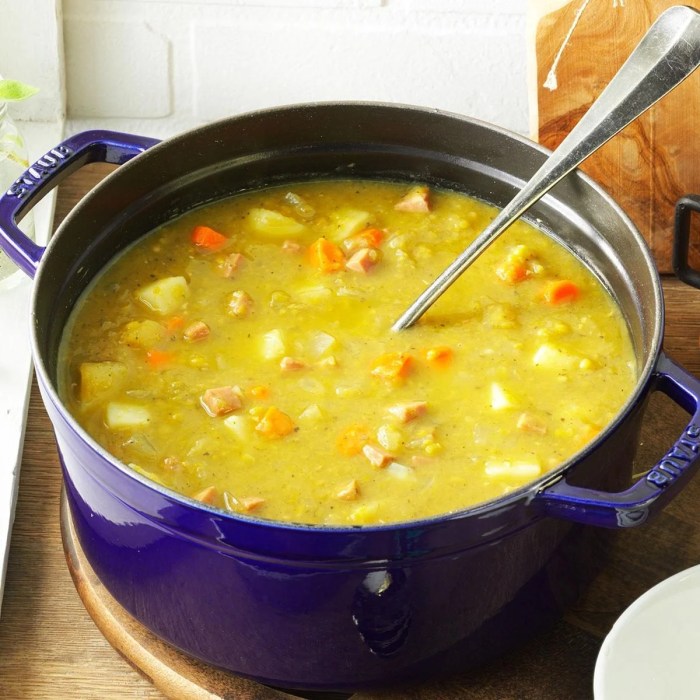
Source: tmbi.com
Proper storage and reheating techniques are crucial for maintaining the quality of leftover pea soup.
Store leftover pea soup in airtight containers in the refrigerator at a temperature below 40°F (4°C). It will typically remain safe to eat for 3-4 days. Discard any soup that shows signs of spoilage, such as an off odor or unusual color changes. Reheating can be done on the stovetop or in the microwave. Stovetop reheating offers more even heating and better texture retention.
Microwave reheating is faster but can sometimes lead to uneven heating and a slightly altered texture. When reheating, stir frequently to ensure even heating and prevent scorching.
Helpful Answers
Can I use a different type of ham?
Yes, you can substitute with other smoked or cured pork products like smoked pork hocks or even bacon for a smokier flavor. Adjust cooking time as needed.
How long can I store leftover pea soup?
Store leftover pea soup in an airtight container in the refrigerator for up to 3-4 days.
Can I freeze pea soup?
Yes, pea soup freezes well. Allow it to cool completely before freezing in airtight containers for up to 2-3 months.
What if my soup is too thick or too thin?
Add broth or water for thinner consistency; simmer uncovered to thicken a thinner soup. For a smoother soup, blend longer.

